Learning how to grow zucchini, one of the most productive garden vegetables, is easy. The hardest part of growing zucchinis is eating all the fruit :P. In this post, we will talk about how to grow zucchini and things to look out for with squash plants, such as squash bugs, cucumber beetles, and other predators and pests. We’ll also talk about the growing season, how to plant and nurture this vegetable, and how to prevent problems such as fungal diseases. So, if you’re ready to learn more about how to grow zucchini, let’s dive in!
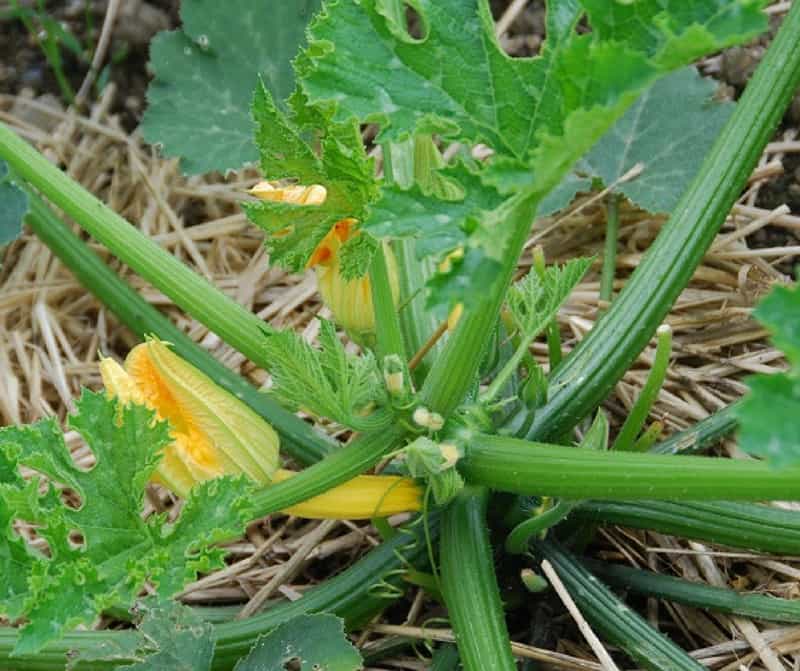
There are some important things to know about growing zucchini, winter squash, summer squash, and other courgettes. You need to know how to spot common issues like blossom end rot, bacterial wilt, and pests.
You need to know how to have the best soil moisture and soil type, what healthy zucchini leaves look like, and also how to identify common zucchini pests. Once you learn the basics, you will find that your vegetable garden comes to life with zucchini.
Make sure to plant some companion plants for zucchini to help your plants thrive.
In fact, you may need to be creative with all the wonderful fruits they produce, as each plant could provide you with more than 10 pounds. Maybe you have some friends or neighbors you can share with? They are such prolific producers, they are also great for farmers who like to sell or trade their goods at the market.
And if you leave them growing while you take your summer vacation, you might come home to huge zucchinis in your garden. Never fear, you can still use the oversized zucchinis in breads, fritters, soups, and salads.
Zucchini recipes
Best Soil For Growing Zucchini
Choosing the right garden soil is the first step to having successful growth from your plants. Zucchini plants (or courgettes as they are known in Europe) are very prolific and high-yielding. Because of this, they need highly fertile soil. They also prefer a well-drained bed so it is important that you dig some organic matter into the soil.
To create the perfect courgette bed, dig a bit of well-rotted manure into the soil, either during the fall prior to planting, or in late winter. In addition, just before planting, dress the bed with plenty of garden compost.
It is also a good idea to add a little fish, blood, and bone fertilizer when you plant zucchini. Warm soil is advised and you want to plant after the last frost date so there is no danger of frost that can kill the plants before they can even get started. Let’s look at some important things to know about how to start seeds and grow your zucchini.
How To Grow Zucchini
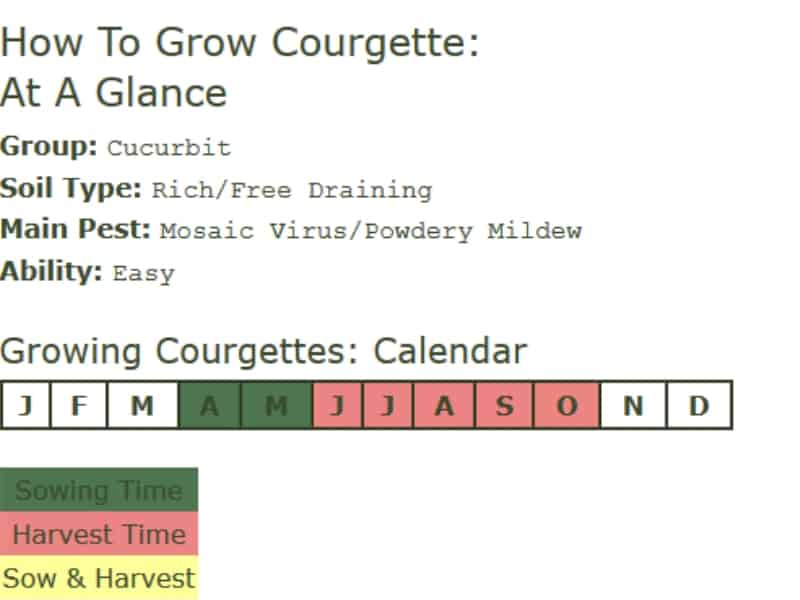
Sow zucchini indoors or in a greenhouse at the end of April, or the beginning of May. Use general all-purpose compost in a pot about 6-8 inches, sowing the seed about 1½ inches deep. Healthy plants will come from succession planting and from choosing the right time to plant.
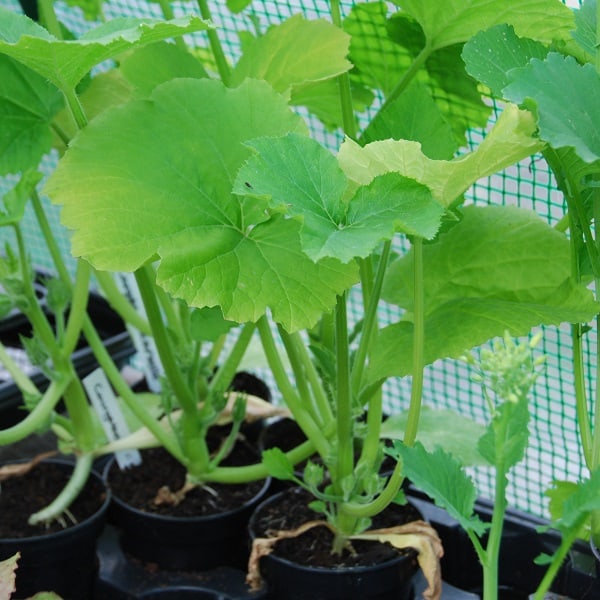
Zucchini seeds rarely fail, so use one seed per pot. We recommend that you sow the seed lying on a side edge, rather than laying them flat. This will stop the zucchini seeds from rotting in the wet compost.
Once the seedlings have grown to a healthy size, transplant them to their final growing place. Space each plant about three feet from each other. Be sure there is enough space between them for when they grow. They also require good air circulation and good pollination to do their best.
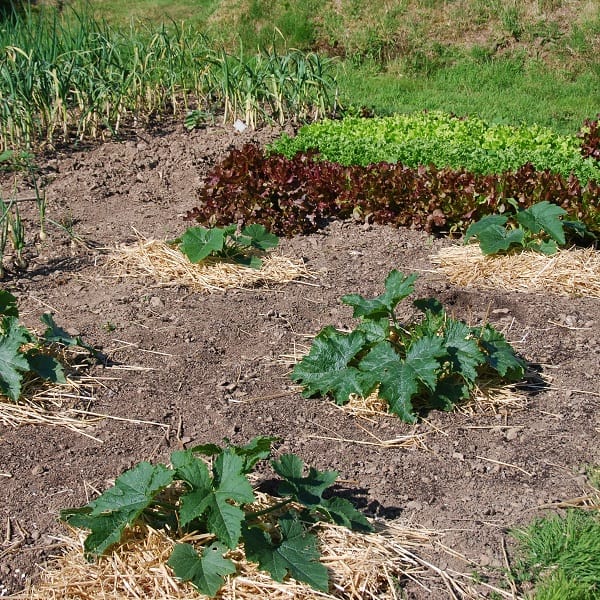
Mulch each plant with straw. It helps to retain moisture in the soil and stops weeds from growing.
Once the zucchini plants start producing, it is recommended that you feed them every week with liquid tomato food. Feeding the zucchini helps them maintain their crop production.
The most difficult decision to make in how to grow zucchini is how many plants you will need.
We love zucchini and since they are such a versatile vegetable, we grow plenty. The fruit can be frozen or canned, as well as eaten fresh, either cooked or raw. By the time the season ends, we have bags of frozen zucchinis, a range of zucchini soups, and some ratatouille.
To give you an idea of how many plants you will need, each plant will produce around 30 zucchinis. When we make ratatouille for four, we use two or three small-to-medium sized ones.
Therefore, unless you love zucchinis, I suggest that you start with three plants and see if you can use them all. Who knows? Next year you might like to grow 10 plants as we do ;).
Can you grow zucchini in a pot?
If you’re a container gardener, you may be wondering if your zucchini will be as successful. If you lack space, growing zucchini in a pot can work well for you. Just make sure you use the largest pot you can in your space and don’t plant more than 2 plants per pot.
Here’s how to plant your zucchini in a container: I LOVE how he uses sand to maintain moisture. Very smart!
Can you grow zucchini on a trellis or vertically?
Another way to grow zucchini in a small space is to train it up a trellis. All you need to do is train the zucchini plant up your trellis or stake, and tie it up with some natural jute twine (this is the one I use in my garden).
How to grow zucchini upward
A couple of days ago I “met ” Pam in a gardening Facebook group and she shared her experience growing zucchini vertically. This is an image of her zucchini plants staked up: they are beautiful!
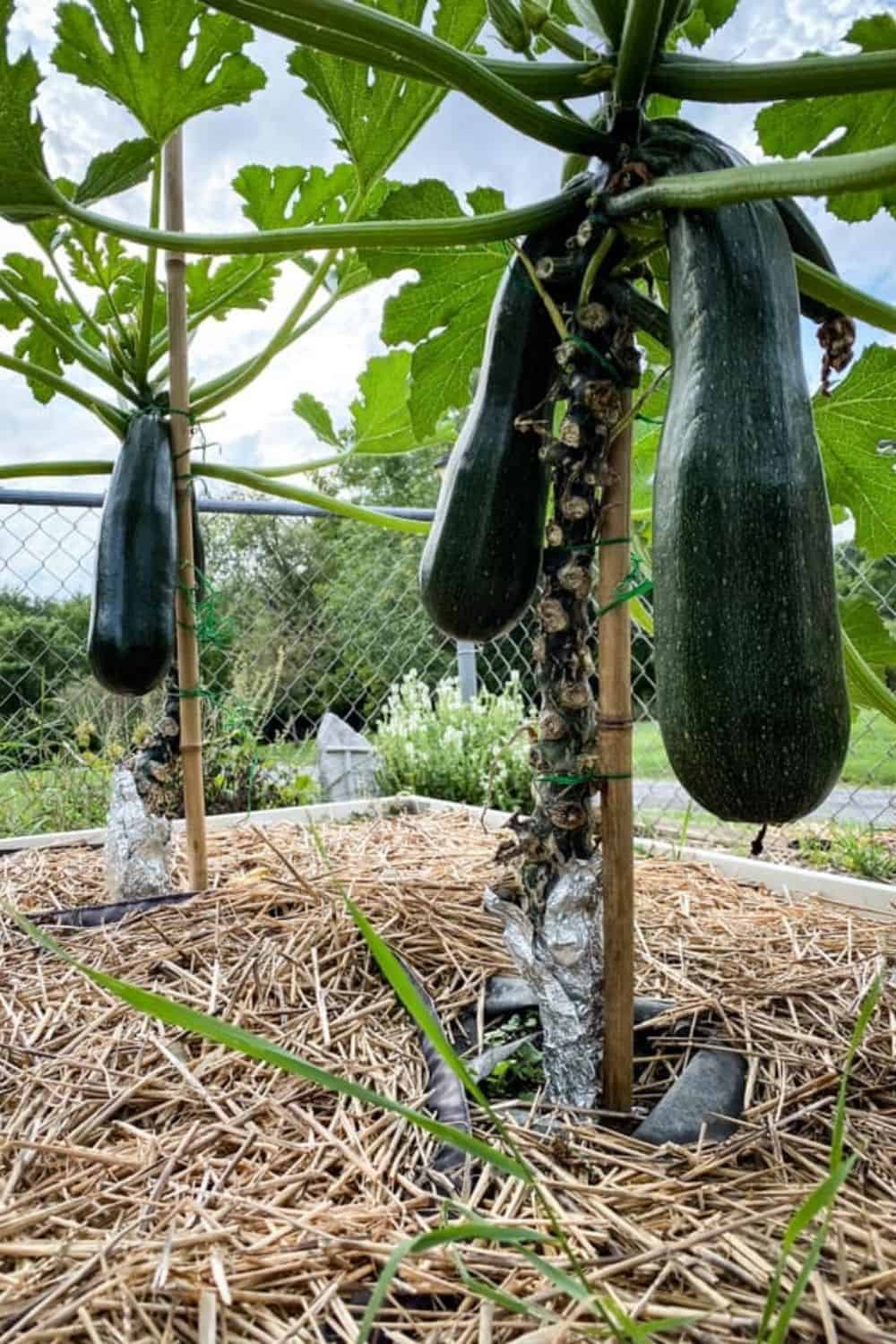
Pam planted her zucchini and immediately “planted” a strong stake (like the ones you use for tomatoes) next to her zucchini plant. If you do this early, the plant is very flexible, and easily trained to go grow upwards.
As the plant grows, remove the lower leaves, and wrap the stem in aluminum foil. This keeps the zucchini plant safe from vine borers. You can also wrap it in pantyhose if you prefer those.
Reasons for growing zucchini vertically
Here are the reasons why Pam prefers this method as opposed to the traditional way.
- DOES NOT TAKE OVER YOUR GARDEN!!!! This is huge for those with limited space.
- I don’t have to hunt for my zucchini. It is easy to see.
- Since I trim the leaves below the new fruit, I don’t have as many leaves to check for critters. I easily found my squash bug eggs and they never became a problem.
- With the stalk exposed, I immediately noticed when the vine borer attacked. I saw the frass, slit the stalk a bit, and apparently killed the grubs by poking away. I thought I was going to lose a plant, but they weren’t bothered by it.
- The flowers are easily exposed to pollination. I can easily see the male and females for self-pollination – just to make sure.
- The stem is easy to wrap to ward off the vine borers. I didn’t apply the aluminum foil high enough this time and had a problem.
- Lastly, they look super cool. like miniature palm trees!!!!
- Simple to do. Stick a rod in the ground and tie the stem to it as it grows.
If you’re a visual learner, like I am, this video will show you everything you need to grow zucchini and squash vertically.
Can you grow zucchini indoors?
You might wonder if you could grow zucchini indoors. It’s possible if you have the right conditions. This plant loves full sun, so you’ll need a sunny room.
It’s also huge, so you need quite a bit of space. If you do, growing zucchini indoors would be a great way to prolong your zucchini’s productivity. Just bring your potted plant indoors and enjoy the extra fruit.
Pests And Diseases of Zucchini
However you decide to grow your zucchini, an important part of the process will be preventing pests. Things like spider mites, slugs, cucumber beetles, vine borers, whiteflies, aphids, and squash bugs can all attack your zucchini.
Here are some tips for common pest control.
Slugs
As with most vegetable plants, slugs can be a problem. Straw mulch and a few beer traps will keep slug problems to a minimum.
You can also add some crushed eggshells around the plants.
Cucumber Mosaic Virus
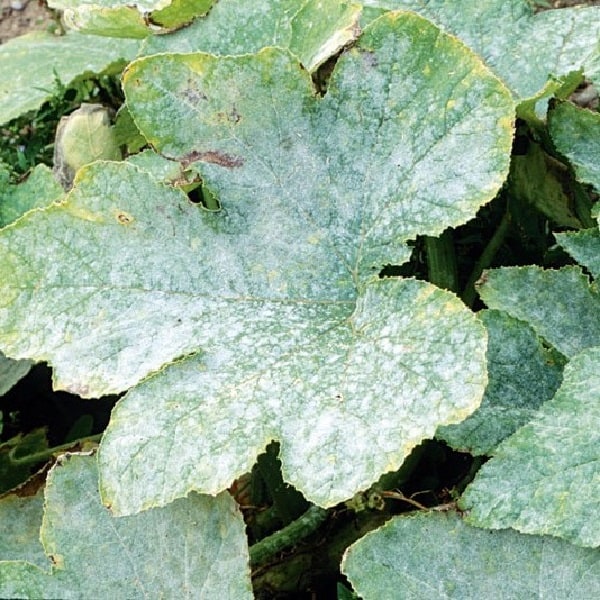
This virus can affect zucchini plants. The virus causes courgette leaves to have a yellow mottling and sometimes be distorted or stunted.
There is no control for this virus. However, as it is transmitted by aphids, an effective control of greenfly and black fly can help to control the virus. It would also be a good idea to dispose of infected plants, washing your hands before handling any other plants.
Some other things to look out for are common diseases, calcium deficiency, poor pollination, blossom-end rot, and mildew.
Powdery mildew
Another problem that is perhaps more common in zucchini plants is powdery mildew or downy mildew. This is a fungal infection that coats the leaves with a white powdery substance.
Powdery mildew is often said to be associated with lack of water, or water stress. However, this fungus has an unusually high water content itself, which gives it the ability to establish in very dry conditions. This ability is unusual for a fungus, so it may be possible that the association with dry conditions is a bit misleading.
There is a milk treatment for powdery mildew that works as a preventive rather than a cure. Diluted milk with water, making a spray with about 25% milk. Spray this diluted milk on the plants every other week. This won’t cure the plant, but if you remove infected leaves and spray new and emerging leaves, then you should stop the mildew from spreading.
Harvesting Zucchini
Collecting zucchini is easy. When the zucchini is the size you like, simply cut the fruit from the plant using a sharp knife or garden shears. As with other vegetables, the more you pick, the more the plant will produce.
Your home garden center or local garden store can help you with supplies to make it easier to harvest your zucchini but if you’re a regular gardener, you likely already have everything you need on hand.
You might also choose to plant them in biodegradable pots, but this is another personal choice to make and not a requirement. Remember, they are fast growers and easy to care for. They make a great starter plant for new gardeners or children who are learning, too.
Cooking With Zucchini
Zucchinis are extremely versatile. When you have a glut of these vegetables, there are many ways you can use them.
If you are anything like us and can’t wait to start eating your own homegrown vegetables, you will enjoy your early season zucchinis. They will probably be the smallest you will pick all year. Small squash is perfect for grilling or serving with a salad, dressed with olive oil, sea salt, and black pepper.
In fact, most sizes of zucchinis are perfect for salads. Pick larger fruits and slice them lengthwise, pan fry and cool them, then mix with any salad. This preparation also works well with pasta, and tomato or pesto sauce.
If your zucchini get a bit too big, you can slice them and use them as pasta “noodles” to make lasagna. Or cook them down with onions to make all sorts of soups. We use them sliced or diced in soups.
Gigantic ones, those that hide and sneakily get bigger and bigger, are wonderfully grated and made into zucchini bread or fritters.
Zucchinis can be used in tarts and quiches, in baking, for pickling or chutneys, stir-fries, frittatas, and pizzas. Or stuff your courgettes and bake them.
Even the flowers can be battered and fried (but then you won’t get any more squash).
You can also freeze zucchinis, although the extra water content can make them a bit soggy when defrosted. Because of this, don’t use water to blanch them. Instead, lightly sauté them. Then cool and tray them in a single layer to freeze. You can use these frozen zucchinis straight from the freezer as and when they are needed.
What Will I Do with All Those Courgettes? by Elaine Borish may give you additional ideas. It has some fantastic reviews!
Of course, you can also share your abundance and create a better world. Donate your extra zucchinis to the local food pantry or give them to your friends and neighbors.
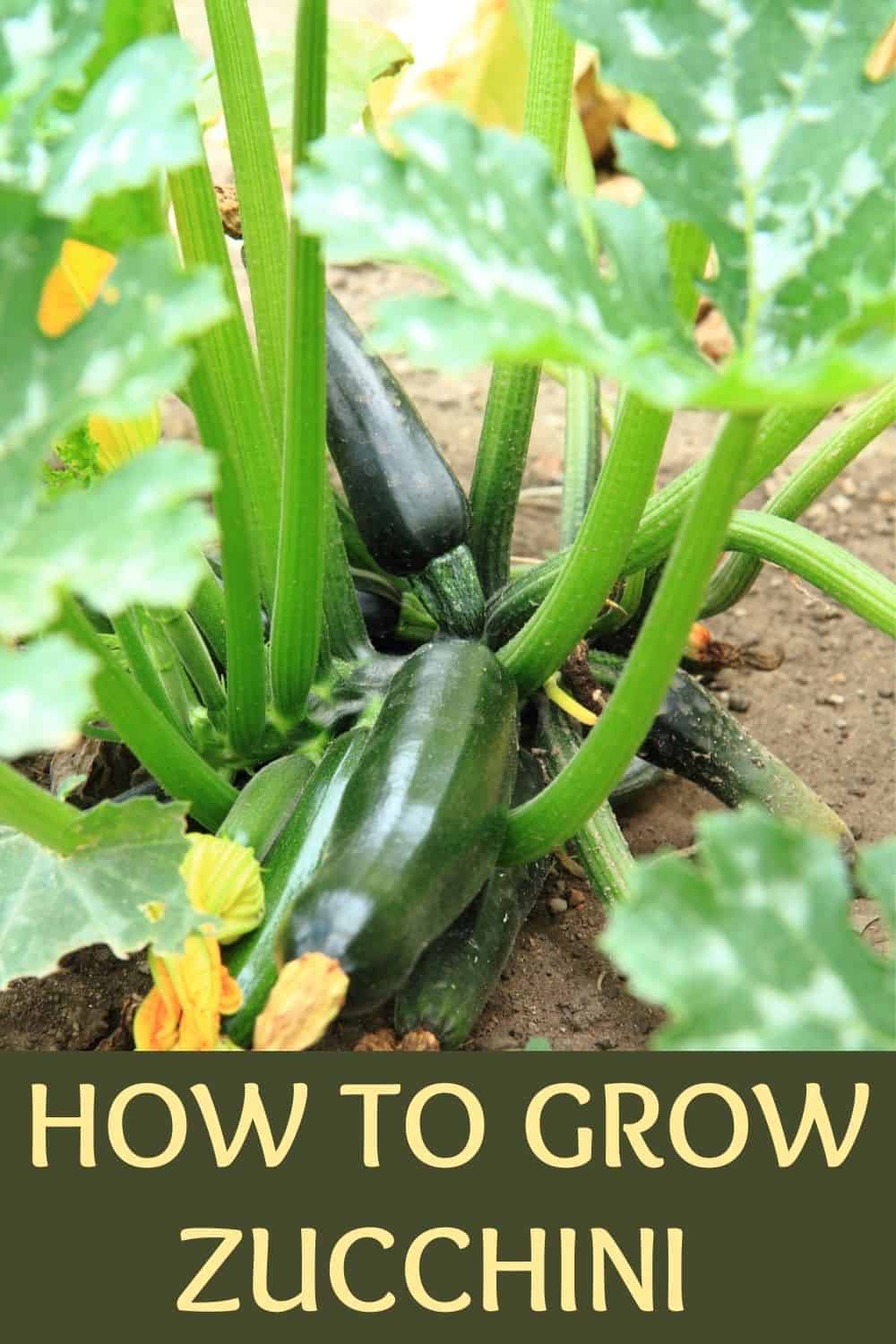


11 Great Companion Plants For Sunflowers (And 3 To Avoid)
Friday 30th of June 2023
[…] Here’s all you need to know about growing zucchini. […]
8 Best Companion Plants For Squash (And 4 To Avoid)
Sunday 23rd of April 2023
[…] you’re growing zucchini, yellow squash, winter squash, or pumpkins, plant a few companions nearby to help them grow healthy […]
15 Delicious Fried Zucchini Recipes
Friday 26th of August 2022
[…] if you plant zucchini every year, and will be making all these fried zucchini recipes, you might as well make your life […]
What To Do With Too Much Zucchini - 12 Great Ideas For Surplus
Friday 26th of August 2022
[…] you grow your own zucchini, you may find yourself with a lot on hand. But there’s no such thing as too much zucchini if […]
joseph
Sunday 6th of February 2022
This is the first time I saw zucchini grown upright. Can yellow squash be grown upright? Also, I'm trying it this year.
Adriana
Sunday 6th of February 2022
It should work the same. Wishing you success with it this summer :)